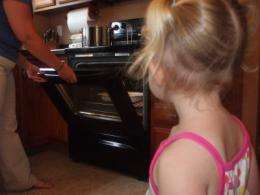Child burn injuries down significantly (w/ Video)

In the next 60 seconds, another child will be on his/her way to the hospital to be treated for serious burns; it happens more than 300 times a day in this country. Now, one of the largest studies ever done on burn injuries in kids is out from experts at Nationwide Children's Hospital and the results are mixed: while overall injuries are down, there are some kids who are still at serious risk.
Lily McKinney has always loved spending time in the kitchen; whenever anyone is cooking she's willing to do anything to help. But in an instant, Lilly's eagerness to help ended up getting her hurt.
"My husband was checking on the lasagna that was in the oven and she snuck right around him and just put her hands right on the oven door," says Lilly's mother Danette McKinney.
Lilly was left with second-degree burns on both hands. She spent a night in the hospital and weeks in bandages. It's kids like Lilly that are still getting burned at a surprising rate, according to the study.
"We found that kids under age six were actually injured the most, representing about 60 percent of all burn-related injuries," says Lara McKenzie, PhD, a researcher at Nationwide Children's Hospital.
Dr. McKenzie found that while burn injuries have dropped 31 percent overall since 1990, the numbers are still disproportionately high in children under six years of age.
Over the 17-year study period, there were more than 2 million burn-related injuries in this age group, or about 120,000 burns annually.
"For younger children, particularly kids under six, have thinner skin than older children or adults, and they'll actually burn faster, even when exposure time is short," says McKenzie.
Dr. McKenzie, who is also with Ohio State, says many hazards are at eye-level in this age group and in toddlers, their new-found mobility often catches parents off-guard.
"I think we tend to overestimate the reach and ability of children, especially young children and toddlers. They can really reach a lot of surfaces and different hazards," she says.
Experts suggest you sit on the floor in danger zones in your house, like the kitchen, to see your home from your kids' perspective. Seeing the world from their eyes, they say, can help open your eyes to dangers you may not have noticed.
More information: Pediatric Burn Injuries Treated in Emergency Departments in the United States: 1990-2006; Pediatrics, Vol. 124 No. 5, November 2009.
Burns are a common cause of pediatric injury worldwide, typically resulting from hot water, flames, hot surfaces, chemicals and electrical appliances. A recent study conducted by the Center for Injury Research and Policy of The Research Institute at Nationwide Children's Hospital, found that from 1990-2006 more than 2 million children younger than 21 were treated in hospital emergency departments for burn-related injuries. The good news that resulted from the 17-year study period is that researchers saw a 31 percent decrease in the rate of burn-related injuries. The bad news is that children are still being injured from burns - about 120,000 each year.
"The decrease in the burn-related injury rate over the study period is notable," said study author Lara McKenzie, PhD, principal investigator at the Center for Injury Research and Policy at Nationwide Children's Hospital. "However, the disproportionately high number of injuries and the severity of these burns to young children is still cause for concern."
Data from the study, being released online October 5 and appearing in the November issue of Pediatrics, show that children younger than 6 accounted for more than half of all burn-related injuries. Among that age group, most injuries occurred in the home, and the majority (60 percent) resulted from thermal burns. The hands and fingers were the most frequently injured body parts (36 percent), followed by the head and face (21 percent).
Dr. McKenzie, also a faculty member of The Ohio State University College of Medicine, said that reasons why younger children suffered a majority of burn-related injuries during the study period may be due to parents underestimating the reach ability of toddlers, and the fact that younger children have thinner skin.
"Parents should be aware of the capability of reach that their toddler may have," continued Dr. McKenzie. "Items that seem out of reach for young children may not be. That risk should be eliminated. Also, young children, especially those under age 6, have thinner skin, and the severity of a burn can be greater for them even at a reduced exposure time."
Parents can help protect their children from burns by setting the water heater thermostat to no higher than 120 degrees Fahrenheit, keeping kids away from the stove, locking up chemicals and covering unused electrical outlets. Parents should prohibit young children from operating microwaves or other electrical appliances, preparing hot food or drinks, and playing near the kitchen during food preparation.
"Burn-related injuries are potentially preventable with better education, warnings and instructions on consumer products," said Dr. McKenzie. "Increased efforts are needed to improve burn prevention strategies and target households with young children."
Source: Nationwide Children's Hospital (news : web)















